Chinese Noodles 101: The Chinese Egg Noodle Style Guide
How to work with these Chinese versatile staples.
From crispy pan-fried noodles to a bowl of wonton noodle soup, fresh Chinese egg noodles are a staple of Chinese restaurants. Just like Italian pasta or ramen, when cooked properly, they should have a firm bite and springy texture, and the wide variation in thickness and springiness makes Chinese egg noodles some of the most versatile to cook with.
If you're new to cooking with fresh Chinese egg noodles, the assortment of varieties can be a little overwhelming. Located in the refrigerated section at most Asian markets, fresh egg noodles are yellow and mainly made with wheat flour and eggs. But just because they look like egg noodles, doesn't mean they are! Some varieties of alkaline noodles have a yellow appearance, while some brands dye their noodles yellow to skimp on the eggs. Make sure you check the label for real eggs when purchasing any of the varieties listed below.
Just like all fresh pasta, fresh Chinese egg noodles should be kept in their original sealed package in the refrigerator until ready to cook, and once opened, will last only a couple of days. Unopened, they should be good for about a week, but remember to check the expiration date!
The most common varieties of fresh egg noodles you'll find are wonton noodles, Hong Kong-style (chow mein) noodles, and lo mein noodles. Here's a closer look.
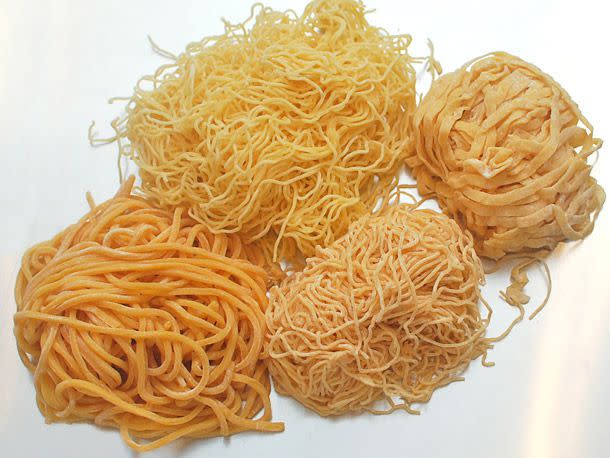
Serious Eats / Shao Z.
Wonton Noodles
Thin Wonton Noodles
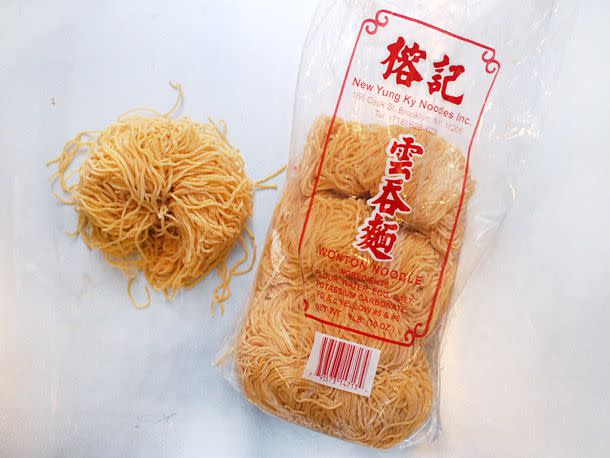
Serious Eats / Shao Z.
Use: In light and delicate broths or simple sauces where the noodle is the star.
This is the kind of thin, springy noodle you find in wonton noodle soup. It's perfect for dishes like this wonton noodle soup with chicken and shiitakes where the broth is light and delicate. Think chicken soups or wonton soups made with a mixture of pork and seafood. They're also great in very simple dishes cooked with ginger and scallions or oyster sauce; any dish where the noodle is really the star. They're often served by boiling, draining, then drizzling with sizzling oil and topping with a simple sauce.
Wide Wonton Noodles
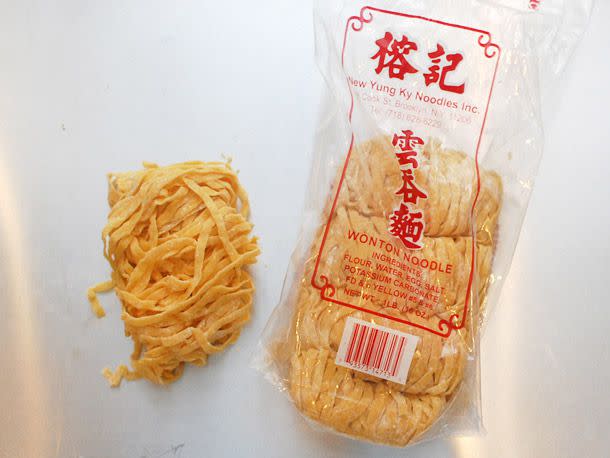
Serious Eats / Shao Z.
Use: In hearty noodle soups, braises, or dishes with heavier, oilier flavors.
Similar to thin wonton noodles but...thicker. I use these noodles for heartier noodle soups, like this Taiwanese beef noodle soup, or other dishes with braised beef and heavier, oilier flavors.
How to Cook Wonton Noodles
First, bring a large pot of salted water to boil. Once boiling, add the noodles and spread them out with a set of long chopsticks or tongs. You want to stir them quite vigorously to make sure they're separated—they have a tendency to stick together.
The thin and wide wonton noodles take about 30 to 40 seconds to cook and should never be boiled for longer than a minute. Once they are done, drain them in a colander. If you are using the noodles in a soup, rinse the noodles under cold running water and drain well. Since the noodles will be sitting in hot broth, you want to minimize any further cooking.
Tip
Thin and wide wonton noodles take about 30 to 40 seconds to cook and should never be boiled for longer than a minute.
If you're using them in a simple stir-fried dish, to rinse or not to rinse depends on the sauce that's being mixed in or drizzle on top. My rule of thumb is that if it's going to take longer than five minutes for you to prepare the sauce, then you should rinse the noodles under cold running water.
The important thing to remember is the texture of the noodles. You want them to have that nice springy texture—overcooking spells death.
Hong Kong-Style Pan-Fried (Chow Mein) Noodles
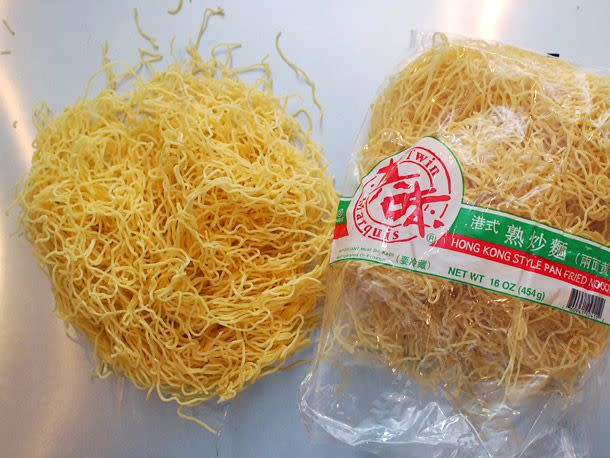
Serious Eats / Shao Z.
Use: In stir-fried dishes.
Sometimes also labeled as chow mein noodles, these look similar to thin wonton noodles. The main difference is that noodles labeled "Hong Kong" or "pan-fried noodles" are par-cooked in boiling water, which makes them ready to stir-fry. Use this variety for dry stir-fried noodle dishes, like this stir-fried chow mein with four vegetables and whenever you want the noodles to be slightly (or very) crispy.
Tip
If you can't find Hong Kong noodles, boil thin wonton noodles in water until they're just barely tender (under a minute), drain and carefully dry them, and then toss them with just a bit of oil.
If you can't find Hong Kong noodles, you can substitute thin wonton noodles. Boil them in water until they're just barely tender (under a minute), drain and carefully dry them (you don't want any excess moisture if you're planning on stir-frying), and then toss 'em with just a bit of oil.
How to Cook Hong Kong Noodles
Hong Kong noodles are ready to fry. Before cooking, open the package and loosen the noodles in a large bowl or work surface. Sometimes a few strands will be clumped up, so make sure to separate them before they go into a wok or pan. They should either be briefly stir-fried with a thin sauce and cooked until the sauce coats each noodle, or shallow-fried in a bit more oil until they form a crispy cake before they're topped with a saucy stir-fry.
Lo Mein Noodles
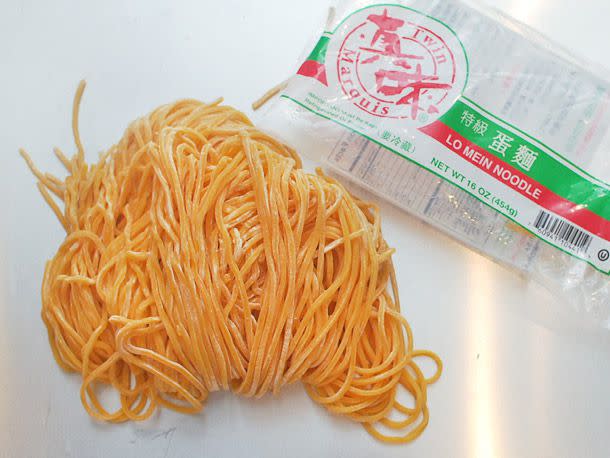
Serious Eats / Shao Z.
Use: In stir-fried noodle dishes with a heavy or rich sauce.
The thickest variety, lo mein is reserved for stir-fried noodle dishes with a heavy or rich sauce. Think sliced beef, like in this stir-fried lo mein with beef and broccoli, or the thick brown gravy you find at food court steam tables. Right off the bat, they're thicker, denser, and less springy than wonton or chow mein noodles, which means that there's less of a loss in quality when they sit for too long or are reheated—they're simply less time-sensitive than other noodles. This is good news if you've got traveling or potlucks on the itinerary, or if you want to make a noodle dish that will still taste good a few days later.
How to Cook Lo Mein Noodles

Serious Eats / Shao Z.
Tip
Lo mein noodles take about three to five minutes to cook in boiling water.
Since the lo mein variety of noodles are thicker than wonton noodles, they usually take about three to five minutes to cook in boiling water. As with wonton noodles, they should be rinsed under cold water if you're not going to serve them immediately.
April 2014
Read More
Read the original article on Serious Eats.